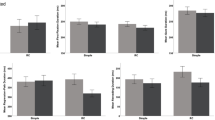Abstract
While self-paced reading and eye-fixation have been used as on-line measures of sentence processing, they provide only indirect evidence as to the exact syntactic state during sentence processing. Two experiments were designed to fill this gap, where garden path sentences in Japanese were used and the marker demanding reanalysis of a previously established syntactic structure appeared at the end of these sentences. Forty-eight students were given a probe verb from an embedded clause and required to quickly identify the subject whose syntactic role could be confirmed only when they later encountered the marker. Findings showed that correct identification was below 50% immediately after the marker (0-sec delay) and increased gradually, reaching 82% at the delay of 4 sec. However, perfect identification was not obtained even for the latter delay condition. The findings indicate that parsers cannot immediately reconstruct the previous syntactic structure but need a certain period of time to reach a final decision. They also suggest that a distinction should be clarified between the moment-to-moment syntactic computation being made and the syntatic structure being constructed during sentence processing.
Similar content being viewed by others
References
Altman, G. T. M. (1988). Ambiguity, parsing strategies, and computational models.Language and Cognitive Processes, 3, 73–97.
Altman, G., & Steedman, M. (1988). Interaction with context during human sentence processing.Cognition, 30, 191–238.
Bever, T. G. (1970). The cognitive basis for linguistic structure. In J. R. Hayes (Ed.),Cognition and the development of language (pp. 279–362). New York: Wiley.
Clifton, C., Jr., & Ferreira, F. (1989). Ambiguity in context.Language and Cognitive Processes, 4, 77–103.
Crain, S., & Steedman, M. (1985). On not being led up the garden path: The use of context by the psychological syntax processor. In D. R. Dowty, L. Karttunen, & A. M. Zwicky (Eds.),Natural language parsing: Psychological, computational and theoretical persperctives (pp. 320–358). New York: Cambridge University Press.
Dell, G. S., McKoon, G., & Ratcliff, R. (1983). The activation of antecedent information during the processing of anaphoric reference in reading.Journal of Verbal Learning and Verbal Behavior, 22, 121–132.
Frazier, L. (1987). Sentence processing: A tutorial review. In M. Coltheart (Ed.),Attention and performance XII (pp. 559–586). Hillsdale, NJ: Erlbaum.
Frazier, L., & Fodor, J. D. (1978). The sausage machine: A new two-stage parsing model.Cognition, 6, 291–325.
Frazier, L., & Rayner, K. (1982). Making and correcting errors during sentence comprehension: Eye movements in the analysis of structurally ambiguous sentences.Cognitive Psychology, 14, 178–210.
Just, M. A., & Carpenter, P. A. (1980). A theory of reading: From eye fixations to comprehension.Psychological Review, 87, 329–354.
Kimball, J. (1973). Seven principles of surface structure parsing in natural language.Cognition, 2, 15–47.
Mazuka, R. (1990). Processing of empty categories in Japanese.Journal of Psycholinguistic Research, 20, 215–232.
Mazuka, R., Itoh, K., Kiritani, S., Niwa, S., Ikejiri, K., & Naitoh, K. (1989). Processing of Japanese garden-path, center-embedded, and multiply-left-embedded sentences: Reading time data from an eye movement study.Annual Bulletin of the Research Institute of Logopedics and Phoniatrics (University of Tokyo),23, 187–212.
Mitchell, D. C. (1987). Lexical guidance in human parsing: Locus and processing characteristics. In M. Coltheart (Ed.),Attention and performance XII (pp. 601–618). Hillsdale, NJ: Erlbaum.
Mitchell, D. C. (1989). Verb guidance and other lexical effects in parsing.Language and Cognitive Processes, 4, 123–154.
Mitchell, D. C., Corley, M. M. B., & Garnham, A. (1992). Effects of context in human sentence parsing: Evidence against a discourse-based proposal mechanism.Journal of Experimental Psychology: Learning, Memory, and Cognition, 18, 69–88.
Nagata, H. (1991). Temporal course of activation of the antecedent by the reflexive in syntactically ambiguous sentences in Japanese.Journal of Psycholinguistic Research, 20, 501–520.
Nagata, H. (1992). Activation of the antecedent by the reflexive in Japanese: A supplementary control experiment.Perceptual and Motor Skills, 74, 99–106.
Nicol, J., & Swinney, D. (1989). The role of structure in coreference assignment during sentence comprehension.Journal of Psycholinguistic Research, 18, 5–19.
Rayner, K., Carlson, M., & Frazier, L. (1983). The interaction of syntax and semantics during sentence processing: Eye movements in the analysis of semantically biased sentences.Journal of Verbal Learning and Verbal Behavior, 22, 358–374.
Rayner, K., Sereno, S. C., Morris, R. K., Schmauder, A. R., & Clifton, C., Jr. (1989). Eye movements and on-line language comprehension processes.Language and Cognitive Processes, 4, SI 21–49.
Singer, M. (1990).Psychology of language. Hillsdale, NJ: Erlbaum.
Steedman, M., & Altman, G. (1989). Ambiguity in context: A reply.Language and Cognitive Processes, 4, 105–122.
Tanenhaus, M. K., Carlson, G., & Trueswell, J. C. (1989). The role of thematic structures in interpretation and parsing.Language and Cognitive Processes, 4, SI 211–234.
Taraban, R., & McClelland, J. L. (1988). Constituent attachment and thematic role assignment in sentence processing: Influences of content-based expectation.Journal of Memory and Language, 27, 597–632.
Taraban, R., & McClelland, J. L. (1990). Parsing and comprehension: A multipleconstraint view. In D. Balota, G. B. Flores d'Arcais, & K. Rayner (Eds.),Comprehension processes in reading (pp. 231–263). Hillsdale, NJ: Erlbaum.
Author information
Authors and Affiliations
Additional information
Deep gratitude is due to Professor D. D. Steinberg for his reading of an earlier version of the paper.
Rights and permissions
About this article
Cite this article
Nagata, H. Unimmediate construction of syntactic structure for garden path sentences in Japanese. J Psycholinguist Res 22, 365–381 (1993). https://doi.org/10.1007/BF01068017
Issue Date:
DOI: https://doi.org/10.1007/BF01068017




